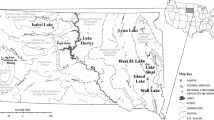Abstract
To determine the significance of mercury contamination of remote lakes in three regions of south-central Ontario, Canada, sediment cores were collected at several stations in each of fourteen lakes. Profiles of Hg concentration with depth were similar to those found in many parts of the world and indicate a substantial increase in Hg loading to these lakes in recent decades. Surficial sediment concentrations (0–2 cm) ranged from 120 to 700 ng/g dry matter.
Whole-lake burdens of Hg, used to determine the source of the contamination, were similar for all lakes in the study. The average anthropogenic component of the burden for all lakes was 0.79 mg/m2. This amount represents approximately one-half of the total burden in the sediments. There was a relationship between the size of a lake's catchment and the whole-lake burden of Hg in lakes in one region of the study area but not the remaining lakes. It is concluded that the major source of the Hg in the study lakes is atmospheric deposition of material originating from outside the catchments and that the contribution from catchment washout is variable.
Similar content being viewed by others
References
Andren AW, Nriagu JO (1979) The global cycle of mercury. In: Nriagu JO (ed) The biogeochemistry of mercury in the environment. Elsevier/North-Holland, Amsterdam, p 1
Armstrong FAJ, Hamilton AL (1973) Pathways of mercury in a polluted northwestern Ontario lake, In: Singer PC (ed) Trace metals and metal-organic interaction in natural waters. Ann Arbor Science Publishers Ann Arbor, MI, p 131
Bjorklund I, Borg H, Johansson K (1984) Mercury in Swedish lakes—Its regional distribution and causes. Ambio 13:118–121
Boutron C, Delmas R (1980) Historical record of global atmospheric pollution revealed in polar icesheets. Ambio 9:210–215
Brinkhurst RO, Chua KE, Batoosingh E (1969) Modifications in sampling procedures as applied to studies on bacteria and tubificid oligochaetes inhabiting aquatic sediments. J Fish Res Board Can 26:2581–2593
Cahill RA, Shimp NF (1984) Inorganic contaminants in Lake Michigan sediments. In: Nriagu J, Simmons M (eds) Toxic substances in the Great Lakes. J Wiley and Sons, New York, p 394
Cornett RJ, Chant L, Link D (1985) Sedimentation of Pb-210 in Laurentian Shield Lakes. Water Pollut Res J Canada 19:97–109
Cox ME, McMurtry GM (1981) Vertical distribution of mercury in sediments from the East Pacific Rise. Nature 289:789–792
Damiani V, Thomas RL (1974) Mercury in the sediments of the Pallanza Basin. Nature 251:696–697
Dillon PJ, Evans RD (1982) Whole lake lead burdens in sediments of lakes in Southern Ontario, Canada. Hydrobiologia 91:121–130
Evans HE, Smith PJ, Dillon PJ (1983) Anthropogenic zinc and cadmium burdens in sediments of selected southern Ontario lakes. Can J Fish Aquat Sci 40:570–569
Evans RD (1980) Measurement of sediment accumulation and phosphorus retention using lead-210 dating. PhD thesis, McGill University, Montreal, Quebec, Canada, 169 pp
Evans RD, Parliament CJ (1984) The measurement of operationally defined lead fractions in sediments from several lakes. Verh Internat Verein Limnol 22:345–350
Evans RD, Rigler FH (1985) Long range transport of anthropogenic lead as measured in lake sediments. Water Air Soil Pollut 24:141–151
Forstner U, Wittmann GTW (1981) Metal pollution in the aquatic environment. Springer-Verlag, Berlin
Hakanson L (1974) Mercury in some Swedish lake sediments. Ambio 3:37–43
- (1977) Sediments as indicators of contamination-investigations in the four largest Swedish lakes. Natl Swed Environ Prot Board SNV PM 839, Uppsala, 159 pp
Hakanson L, Jansson M (1983) Principles of lake sedimentology. Springer-Verlag, Berlin, 177 pp
Kemp ALW, Williams JDH, Thomas RL, Gregory ML (1978) Impact of man's activities on the chemical composition of the sediments of Lakes Superior and Huron. Water Air Soil Pollut 10:381–402
Moore JW, Ramamoorthy S (1984) Heavy metals in natural waters. Springer-Verlag, New York, p 147
Nelson H, Larsen BR, Jenne EA, Sorg DH (1977) Mercury dispersal from lode sources in the Kuskokwim River drainage, Alaska. Science 198:820–824
Ontario Ministry of the Environment, OME (1983) Handbook of analytical methods for environmental samples. OME publication, Toronto, 675 pp
— (1984) Guide to eating Ontario sport fish. OME publication, Toronto, 228 pp
Salomons W, Forstner U (1984) Metals in the hydrocycle. Springer-Verlag, Berlin
Speyer MR (1980) Mercury and selenium concentrations in fish, sediments, and water of two northwestern Quebec lakes. Bull Environ Contamin Toxicol 24:427–432
Takeuchi T (1972) Distribution of mercury in the environment of Minamata Bay and the inland Ariake Sea. In: Hartung R, Dinman BD (eds) Environmental mercury contamination. Ann Arbor Science Publishers Ann Arbor, MI, p 79
Thomas RL (1973) The distribution of mercury in the surficial sediments of Lake Huron. Can J Earth Sci 10:194–204
Ward, GW (1985) The effects of grain size upon metal concentration in two Ontario lakes. BSc Thesis, Trent University, Environmental Studies Program, Peterborough, Canada, 61 PP
Weiss H, Bertine K, Koide M, Goldberg ED (1975) The chemical composition of a Greenland glacier. Geochim Cosmochim Acta 39:1–10
Weiss H, Koide M, Goldberg ED (1971) Mercury in a Greenland icesheet: Evidence of recent input by man. Science 174:692–694
Wren CD, Maccrimmon HR, Loescher BR (1983) Examination of bioaccumulation and biomagnification of metals in a precambrian shield lake. Water Air Soil Pollut 19:277–291
Author information
Authors and Affiliations
Rights and permissions
About this article
Cite this article
Evans, R.D. Sources of mercury contamination in the sediments of small headwater lakes in south-central Ontario, Canada. Arch. Environ. Contam. Toxicol. 15, 505–512 (1986). https://doi.org/10.1007/BF01056562
Received:
Revised:
Issue Date:
DOI: https://doi.org/10.1007/BF01056562




